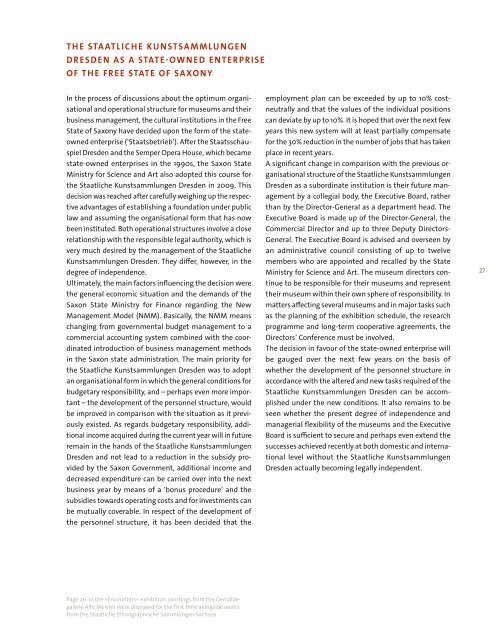2009 - Staatliche Kunstsammlungen Dresden
2009 - Staatliche Kunstsammlungen Dresden
2009 - Staatliche Kunstsammlungen Dresden
You also want an ePaper? Increase the reach of your titles
YUMPU automatically turns print PDFs into web optimized ePapers that Google loves.
tH E StA AtLICH E KU NStSAMMLU NGEN<br />
DRESDEN AS A StAtE-OWN ED ENtERPRISE<br />
OF tH E FREE StAtE OF SAXONY<br />
In the process of discussions about the optimum organisational<br />
and operational structure for museums and their<br />
business management, the cultural institutions in the Free<br />
State of Saxony have decided upon the form of the stateowned<br />
enterprise (‘Staatsbetrieb’). After the Staatsschauspiel<br />
<strong>Dresden</strong> and the Semper Opera House, which became<br />
state-owned enterprises in the 1990s, the Saxon State<br />
Ministry for Science and Art also adopted this course for<br />
the <strong>Staatliche</strong> <strong>Kunstsammlungen</strong> <strong>Dresden</strong> in <strong>2009</strong>. This<br />
decision was reached after carefully weighing up the respective<br />
advantages of establishing a foundation under public<br />
law and assuming the organisational form that has now<br />
been instituted. Both operational structures involve a close<br />
relationship with the responsible legal authority, which is<br />
very much desired by the management of the <strong>Staatliche</strong><br />
<strong>Kunstsammlungen</strong> <strong>Dresden</strong>. They differ, however, in the<br />
degree of independence.<br />
Ultimately, the main factors influencing the decision were<br />
the general economic situation and the demands of the<br />
Saxon State Ministry for Finance regarding the New<br />
Management Model (NMM). Basically, the NMM means<br />
changing from governmental budget management to a<br />
commercial accounting system combined with the coordinated<br />
introduction of business management methods<br />
in the Saxon state administration. The main priority for<br />
the <strong>Staatliche</strong> <strong>Kunstsammlungen</strong> <strong>Dresden</strong> was to adopt<br />
an organisational form in which the general conditions for<br />
budgetary responsibility, and – perhaps even more important<br />
– the development of the personnel structure, would<br />
be improved in comparison with the situation as it previously<br />
existed. As regards budgetary responsibility, additional<br />
income acquired during the current year will in future<br />
remain in the hands of the <strong>Staatliche</strong> <strong>Kunstsammlungen</strong><br />
<strong>Dresden</strong> and not lead to a reduction in the subsidy provided<br />
by the Saxon Government, additional income and<br />
decreased expenditure can be carried over into the next<br />
business year by means of a ‘bonus procedure’ and the<br />
subsidies towards operating costs and for investments can<br />
be mutually coverable. In respect of the development of<br />
the personnel structure, it has been decided that the<br />
Page 26: In the »Encounters« exhibition paintings from the Gemäldegalerie<br />
Alte Meister were displayed for the first time alongside works<br />
from the <strong>Staatliche</strong> Ethnographische Sammlungen Sachsen<br />
employment plan can be exceeded by up to 10% costneutrally<br />
and that the values of the individual positions<br />
can deviate by up to 10%. It is hoped that over the next few<br />
years this new system will at least partially compensate<br />
for the 30% reduction in the number of jobs that has taken<br />
place in recent years.<br />
A significant change in comparison with the previous organisational<br />
structure of the <strong>Staatliche</strong> <strong>Kunstsammlungen</strong><br />
<strong>Dresden</strong> as a subordinate institution is their future management<br />
by a collegial body, the Executive Board, rather<br />
than by the Director-General as a department head. The<br />
Executive Board is made up of the Director-General, the<br />
Commercial Director and up to three Deputy Directors-<br />
General. The Executive Board is advised and overseen by<br />
an administrative council consisting of up to twelve<br />
members who are appointed and recalled by the State<br />
Ministry for Science and Art. The museum directors continue<br />
to be responsible for their museums and represent<br />
their museum within their own sphere of responsibility. In<br />
matters affecting several museums and in major tasks such<br />
as the planning of the exhibition schedule, the research<br />
programme and long-term cooperative agreements, the<br />
Directors’ Conference must be involved.<br />
The decision in favour of the state-owned enterprise will<br />
be gauged over the next few years on the basis of<br />
whether the development of the personnel structure in<br />
accordance with the altered and new tasks required of the<br />
<strong>Staatliche</strong> <strong>Kunstsammlungen</strong> <strong>Dresden</strong> can be accomplished<br />
under the new conditions. It also remains to be<br />
seen whether the present degree of independence and<br />
managerial flexibility of the museums and the Executive<br />
Board is sufficient to secure and perhaps even extend the<br />
successes achieved recently at both domestic and international<br />
level without the <strong>Staatliche</strong> <strong>Kunstsammlungen</strong><br />
<strong>Dresden</strong> actually becoming legally independent.<br />
27

















